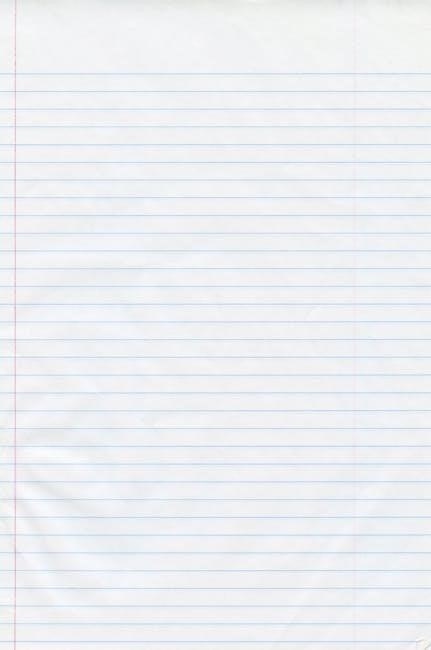
tracing lines worksheets printable pdf
Tracing Lines Worksheets Printable PDF: An Overview
Tracing lines worksheets are a fantastic tool to help young children develop essential pre-writing skills. These worksheets, often available as PDF downloads, provide a fun and engaging way to improve fine motor skills.
Tracing lines worksheets serve as a foundational stepping stone in a child’s early education. These worksheets, typically available in a printable PDF format, are specifically designed to introduce preschoolers and kindergarteners to the fundamental movements required for handwriting. The activity involves following pre-drawn lines, which helps children develop control over their hand movements. These lines can vary from simple straight lines to curved and diagonal patterns, gradually increasing in complexity. The goal is to enhance their fine motor skills, hand-eye coordination, and visual-spatial awareness, all of which are crucial for future academic success. By using tracing lines worksheets, educators and parents can provide a structured and engaging way for children to practice and master these essential pre-writing skills. These worksheets help children get ready to write letters and different shapes.
Importance of Tracing Lines for Preschoolers
Tracing lines worksheets are particularly important for preschoolers as they lay the groundwork for future writing and learning success. At this age, children are developing the fine motor skills necessary for holding a pencil and controlling their hand movements. Tracing lines helps to strengthen these muscles and improve hand-eye coordination, which are both crucial for handwriting. These worksheets also enhance visual-spatial skills, enabling children to understand and replicate different shapes and patterns. By practicing tracing, preschoolers learn to follow a visual path, improving their focus and concentration. This skill is essential for reading and writing, as it helps them track lines of text and form letters accurately. Furthermore, tracing lines provides a fun and engaging way to introduce preschoolers to the concept of writing, making the transition to formal handwriting smoother and more enjoyable. These worksheets can be easily downloaded in PDF format.

Benefits of Using Tracing Lines Worksheets
Using tracing lines worksheets offers numerous benefits for young children, primarily enhancing fine motor skills and hand-eye coordination. These activities also prepare them for handwriting and improve visual-spatial skills.
Development of Fine Motor Skills
Tracing lines worksheets are instrumental in the development of fine motor skills, which are crucial for young children. These skills involve the small muscles of the hands and fingers, which are essential for tasks like writing, drawing, and manipulating objects.
By repeatedly tracing lines, children strengthen these muscles and improve their dexterity. The act of holding a pencil or crayon and carefully following the lines helps them gain better control over their hand movements.
This practice is especially beneficial for preschoolers and kindergartners who are just beginning to develop these skills. Regular use of tracing worksheets can significantly enhance their ability to perform everyday tasks that require fine motor coordination.
Moreover, the variety of lines and shapes found in these worksheets challenges different muscle groups, promoting a well-rounded development of fine motor abilities. This prepares children for more complex tasks in the future.
Enhancing Hand-Eye Coordination
Tracing lines worksheets significantly contribute to enhancing hand-eye coordination in young children. This coordination is the ability to visually process information and then use that information to guide the movements of the hands.
When children trace lines, they are constantly using their eyes to track the path and their hands to follow it. This repeated action strengthens the connection between the eyes and the hands, improving their ability to work together seamlessly.
This skill is crucial for a wide range of activities, from catching a ball to writing letters. By practicing with tracing worksheets, children develop a better sense of spatial awareness and improve their ability to control their hand movements based on what they see.
The different types of lines and shapes in these worksheets also challenge children to adapt their movements, further enhancing their hand-eye coordination. This makes tracing worksheets an invaluable tool for early childhood development.
Preparation for Handwriting
Tracing lines worksheets are a fundamental step in preparing young children for the complexities of handwriting. The act of tracing lines helps children develop the necessary fine motor skills and muscle memory required for forming letters and numbers.
By repeatedly tracing lines, children learn to control their pencil grip and apply the appropriate pressure, which are both essential for legible handwriting. The worksheets also introduce them to the basic strokes and curves that make up the alphabet.
Furthermore, tracing lines helps children understand the directionality of writing, which is crucial for forming letters correctly. They learn to move their pencils from left to right and top to bottom, reinforcing the proper writing conventions.
The practice gained from tracing worksheets builds a solid foundation for future handwriting success. It allows children to develop confidence in their ability to control a writing tool and form shapes accurately, setting them up for a smoother transition to independent writing.
Improving Visual-Spatial Skills
Tracing lines worksheets are not just about handwriting preparation; they also play a vital role in improving a child’s visual-spatial skills. These skills are essential for understanding and interacting with the world around them, including tasks like reading, math, and problem-solving.
By following lines and shapes on the worksheets, children learn to visually analyze and interpret spatial relationships. They develop an awareness of direction, distance, and position, which are all critical components of visual-spatial intelligence.
Tracing activities also help children improve their ability to perceive and differentiate between different shapes and patterns. This skill is particularly important for recognizing letters and numbers, as well as understanding geometric concepts.
Furthermore, tracing lines encourages children to coordinate their visual perception with their motor movements. This hand-eye coordination is crucial for tasks that require precision and accuracy, such as drawing, building, and playing sports.
The development of visual-spatial skills through tracing worksheets can have a lasting impact on a child’s academic and cognitive abilities.

Types of Tracing Lines Worksheets
Tracing lines worksheets come in various forms to cater to different skill levels. From straight and curved lines to shapes, these worksheets offer diverse practice opportunities.
Straight Line Tracing Worksheets
Straight line tracing worksheets are fundamental for early learners, providing a basic introduction to controlled pencil movement. These worksheets typically feature simple, direct paths for children to follow, helping them develop the precision and control needed for handwriting. By repeatedly tracing these lines, children improve their hand-eye coordination and fine motor skills, laying a solid groundwork for more complex writing tasks.
These worksheets often include variations in line thickness and length to further challenge and refine the child’s abilities. The simplicity of straight lines allows children to focus on maintaining a steady hand and consistent pressure, crucial elements in forming letters and numbers later on. Incorporating these worksheets into a regular practice routine can significantly boost a child’s confidence and readiness for formal writing instruction.
Straight line tracing exercises are an essential stepping stone in developing pre-writing skills, making them an invaluable resource for parents and educators alike.
Curved Line Tracing Worksheets
Curved line tracing worksheets introduce a new level of complexity, challenging children to control their pencil movements along non-linear paths. These worksheets often feature gentle arcs, loops, and waves, helping children develop the dexterity and coordination needed for forming rounded letters and shapes. By practicing these curves, children enhance their fine motor skills and improve their ability to smoothly transition between different strokes.
These worksheets can include a variety of curved patterns, each designed to target specific muscle groups in the hand and wrist. The act of tracing curved lines requires more precise control than straight lines, encouraging children to focus on their hand movements and maintain a consistent pressure. This focused practice not only improves handwriting but also enhances visual-spatial skills, as children learn to recognize and replicate different curved forms.
Integrating curved line tracing worksheets into early learning activities provides a valuable foundation for future writing success;
Horizontal Line Tracing Worksheets
Horizontal line tracing worksheets are a fundamental tool in early childhood education, designed to introduce children to the basic movements required for writing. These worksheets typically feature straight lines that run from left to right across the page, helping children develop the hand-eye coordination and fine motor skills necessary for forming letters and numbers.
By practicing tracing horizontal lines, children learn to control their pencil or crayon, maintaining a steady pressure and direction. This exercise helps build muscle memory and improves their ability to maintain focus and concentration. The repetitive nature of tracing also reinforces the concept of directionality, which is crucial for reading and writing from left to right.
These worksheets often include variations in line thickness and length to provide additional challenges. Incorporating fun themes and colorful designs can further engage children, making the learning process enjoyable and effective. Horizontal line tracing worksheets are an essential stepping stone towards mastering handwriting.
Vertical Line Tracing Worksheets
Vertical line tracing worksheets are crucial in early childhood education, focusing on developing essential pre-writing skills. These worksheets feature straight lines running from top to bottom, helping children learn to control their pencil movements in a vertical direction. This practice enhances their hand-eye coordination and fine motor skills, vital for future handwriting success.
By repeatedly tracing these vertical lines, children build muscle memory and improve their ability to maintain a steady, consistent stroke. The activity encourages focus and concentration, as they learn to follow the line accurately. Variations in line thickness and the inclusion of engaging themes can add to the learning experience, keeping children motivated and interested.
These worksheets also help children understand spatial relationships and directionality, preparing them for more complex writing tasks. Vertical line tracing worksheets are an effective and enjoyable way to lay the foundation for confident and legible handwriting.
Diagonal Line Tracing Worksheets

Diagonal line tracing worksheets are an excellent resource for enhancing a child’s pre-writing skills and fine motor control. These worksheets feature lines that slant either upwards or downwards, requiring children to navigate their pencils at an angle. This activity is more challenging than tracing straight horizontal or vertical lines, as it demands greater precision and coordination.

By practicing tracing diagonal lines, children develop better control over their hand movements and improve their ability to follow visual cues. This skill is crucial for forming letters that include diagonal strokes, such as “K,” “X,” and “Z.” The worksheets often incorporate playful themes and illustrations to keep children engaged and motivated.
Furthermore, diagonal line tracing helps children understand spatial relationships and develop their visual-spatial skills. This type of worksheet is an invaluable tool for preparing young learners for the complexities of handwriting and improving their overall motor skills.
Shape Tracing Worksheets
Shape tracing worksheets are an engaging and effective way to introduce young children to basic geometric forms while simultaneously enhancing their fine motor skills. These worksheets typically feature dotted or dashed outlines of shapes such as circles, squares, triangles, and rectangles, which children trace with a pencil or crayon.
Tracing shapes helps children develop hand-eye coordination and spatial awareness, as they learn to control their hand movements to follow the contours of each shape. This activity also reinforces shape recognition, as children visually associate the traced outline with the corresponding shape name. The worksheets can be designed with varying levels of complexity, starting with simple shapes and progressing to more intricate designs.
Furthermore, shape tracing can be incorporated into creative activities, such as coloring within the traced shapes or using them as templates for drawing. This makes learning fun and interactive, encouraging children to practice their fine motor skills and shape recognition in an enjoyable context. Shape tracing worksheets are a valuable tool for early childhood education.

Where to Find Printable Tracing Lines Worksheets
Numerous online resources offer printable tracing lines worksheets in PDF format. These resources provide a variety of options, catering to different skill levels and interests, making them easily accessible.
Online Resources for Free PDF Downloads
The internet is a treasure trove of free resources for tracing lines worksheets in PDF format. Many websites specialize in educational printables, offering a wide selection of worksheets designed to help children develop pre-writing skills. These sites often provide various types of lines, including straight, curved, horizontal, vertical, and diagonal, catering to different learning stages.
Parents and educators can easily find and download these worksheets, making them a convenient and cost-effective way to supplement learning activities. Some websites also offer themed worksheets featuring animals, shapes, or other engaging visuals to capture children’s attention. Look for reputable educational websites and blogs that provide high-quality, free PDF downloads. Ensure the worksheets are age-appropriate and align with the child’s skill level. Always preview the worksheets before printing to ensure they meet your specific needs and preferences. These online resources provide a wealth of opportunities to support children’s fine motor skill development and prepare them for handwriting success.
Creating Custom Tracing Worksheets
While numerous online resources offer pre-made tracing lines worksheets, creating custom worksheets allows for tailored learning experiences. This approach enables you to target specific skills or interests, making the activity more engaging for the child. Several user-friendly online tools and software programs are available for designing your own tracing worksheets.

These platforms often provide customizable templates where you can adjust line styles, thickness, and complexity. You can also incorporate images, shapes, or themes that resonate with the child’s interests, such as favorite animals or cartoon characters. Creating custom worksheets allows you to focus on specific areas where the child needs extra practice, such as particular letter formations or number shapes. Furthermore, you can adjust the difficulty level to match the child’s progress, ensuring a challenging yet achievable learning experience. By creating personalized tracing worksheets, you can cater to individual learning styles and make the practice more enjoyable and effective.

Tips for Using Tracing Lines Worksheets Effectively
To maximize the benefits of tracing lines worksheets, consider making them reusable by laminating them. Incorporate the worksheets into daily routines for consistent practice and engage children with fun, themed designs.
Making Worksheets Reusable
One of the most practical tips for using tracing lines worksheets effectively is to make them reusable. This not only saves paper but also allows children to practice the same patterns repeatedly, reinforcing their fine motor skills and hand-eye coordination.
Laminating the worksheets is a simple and effective way to achieve this. Once laminated, children can use dry-erase markers to trace the lines. After each use, the marks can be easily wiped away, making the worksheet ready for the next practice session.
Alternatively, you can use sheet protectors instead of lamination for a less permanent solution. This allows you to easily switch out different worksheets as needed, providing variety and keeping children engaged. Reusable worksheets are a cost-effective and environmentally friendly way to support early learning.
Incorporating Worksheets into Daily Routines
To maximize the benefits of tracing lines worksheets, it’s essential to seamlessly integrate them into a child’s daily routine. Consistency is key to developing fine motor skills and preparing for handwriting.
Start by setting aside a specific time each day for tracing activities. This could be during breakfast, after playtime, or before bedtime. Creating a regular schedule helps children anticipate and accept tracing as part of their daily learning.
Keep the worksheets readily accessible in a designated area, such as a learning corner or a special drawer. This makes it easy to grab a worksheet whenever there’s a free moment.
You can also incorporate tracing into other activities. For example, while reading a book, encourage children to trace the shapes of objects they see in the illustrations. By making tracing a natural part of the day, you foster a love for learning and skill development.
Engaging Children with Fun Themes
To truly capture a child’s attention and enthusiasm, infuse tracing lines worksheets with exciting and imaginative themes. This transforms a simple exercise into an adventure, making learning enjoyable and memorable.
Consider incorporating themes that resonate with children’s interests, such as animals, vehicles, or favorite characters. Create worksheets featuring dotted lines that form the shapes of these themes, allowing children to trace their way through a jungle, race track, or magical kingdom.

Use vibrant colors and engaging illustrations to further enhance the visual appeal of the worksheets. Children are naturally drawn to bright and cheerful designs, which can help motivate them to participate and complete the activities.
You can also create themed tracing books or folders, organizing worksheets based on different topics. This not only keeps the activities organized but also allows children to choose themes that align with their current interests, fostering a sense of ownership and engagement.

The Value of Tracing Lines Practice
Tracing lines provides a direct and effective way to develop fine motor skills, which are essential for tasks like writing, drawing, and using utensils. By strengthening the small muscles in their hands and fingers, children gain greater control and precision in their movements.
Furthermore, tracing lines enhances hand-eye coordination, a critical skill for various activities, including sports, playing musical instruments, and even everyday tasks like buttoning clothes. The act of visually following a line and coordinating hand movements to trace it strengthens the connection between the eyes and the hands.
Ultimately, incorporating tracing lines practice into a child’s routine is an investment in their future. It equips them with the fundamental skills and confidence they need to thrive in school and beyond.